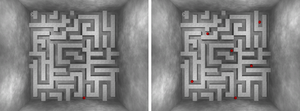Information
- Publication Type: Conference Paper
- Workgroup(s)/Project(s):
- Date: August 2008
- ISBN: 978-1-59593-981-4
- Publisher: ACM
- Location: Los Angeles, California
- Lecturer: Veronica Sundstedt
- Editor: Sarah Creem-Regehr and Karol Myszkowski
- DOI: 10.1145/1394281.1394288
- Booktitle: ACM Symposium on Applied Perception in Graphics and Visualization 2008
- Conference date: 9. August 2008
– 10. August 2008
- Pages: 43 – 50
- Keywords: saliency, eye tracking, electronic games, visual attention, psychophysics
Abstract
Prediction of gaze behavior in gaming environments can be a tremendously useful asset to game designers, enabling them to improve gameplay, selectively increase visual fidelity, and optimize the distribution of computing resources. The use of saliency maps is currently being advocated as the method of choice for predicting visual attention, crucially under the assumption that no specific task is present. This is achieved by analyzing images for low-level features such as motion, contrast, luminance, etc. However, the majority of computer games are designed to be easily understood and pose a task readily apparent to most players. Our psychophysical experiment shows that in a task-oriented context such as gaming, the predictive power of saliency maps at design time can be weak. Thus, we argue that a more involved protocol utilizing eye tracking, as part of the computer game design cycle, can be sufficiently robust to succeed in predicting fixation behavior of players.
Additional Files and Images
Additional images and videos
Additional files
Weblinks
BibTeX
@inproceedings{SUNDSTEDT-2008-ASF,
title = "A Psychophysical Study of Fixation Behavior in a Computer
Game",
author = "Veronica Sundstedt and Efstathios Stavrakis and Michael
Wimmer and Erik Reinhard",
year = "2008",
abstract = "Prediction of gaze behavior in gaming environments can be a
tremendously useful asset to game designers, enabling them
to improve gameplay, selectively increase visual fidelity,
and optimize the distribution of computing resources. The
use of saliency maps is currently being advocated as the
method of choice for predicting visual attention, crucially
under the assumption that no specific task is present. This
is achieved by analyzing images for low-level features such
as motion, contrast, luminance, etc. However, the majority
of computer games are designed to be easily understood and
pose a task readily apparent to most players. Our
psychophysical experiment shows that in a task-oriented
context such as gaming, the predictive power of saliency
maps at design time can be weak. Thus, we argue that a more
involved protocol utilizing eye tracking, as part of the
computer game design cycle, can be sufficiently robust to
succeed in predicting fixation behavior of players.",
month = aug,
isbn = "978-1-59593-981-4",
publisher = "ACM",
location = "Los Angeles, California",
editor = "Sarah Creem-Regehr and Karol Myszkowski",
doi = "10.1145/1394281.1394288",
booktitle = "ACM Symposium on Applied Perception in Graphics and
Visualization 2008",
pages = "43--50",
keywords = "saliency, eye tracking, electronic games, visual attention,
psychophysics",
URL = "https://www.cg.tuwien.ac.at/research/publications/2008/SUNDSTEDT-2008-ASF/",
}


 draft
draft
